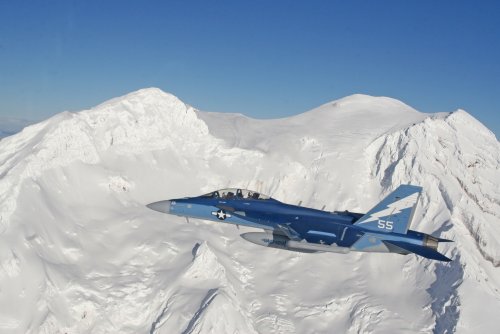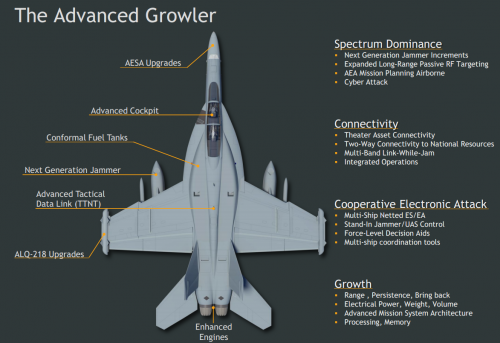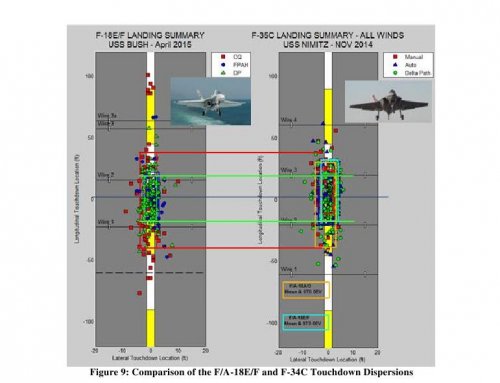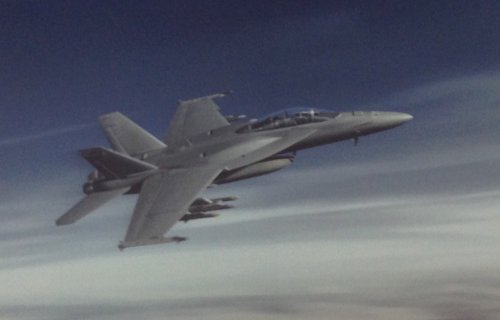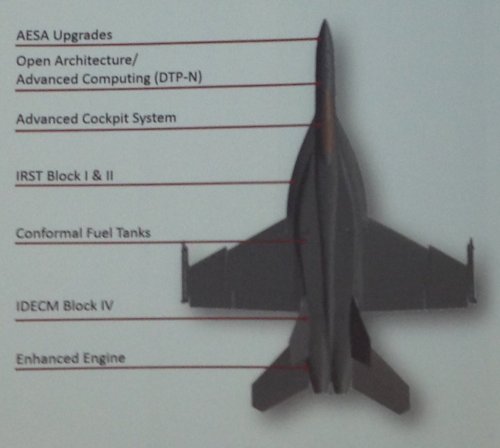I was hoping that the Navy might acquire the Boeing F/A-18H King Hornet along with the F-35C. 
You are using an out of date browser. It may not display this or other websites correctly.
You should upgrade or use an alternative browser.
You should upgrade or use an alternative browser.
Boeing F/A-18E/F Super Hornet
- Thread starter rousseau
- Start date
-
- Tags
- boeing super hornet usa
kagemusha
ACCESS: Restricted
- Joined
- 1 February 2010
- Messages
- 48
- Reaction score
- 15
Photos of the F/A-18 with chevron nozzles.
https://www.flickr.com/photos/navycurrents/16456034027/in/photostream/
https://www.flickr.com/photos/navycurrents/16456034027/in/photostream/
Triton said:I was hoping that the Navy might acquire the Boeing F/A-18H King Hornet along with the F-35C.
Whoever came up with "King Stallion" clearly didn't think it through. ;D
- Joined
- 3 June 2006
- Messages
- 3,089
- Reaction score
- 3,924
Great find, kagemusha!kagemusha said:Photos of the F/A-18 with chevron nozzles.
https://www.flickr.com/photos/navycurrents/16456034027/in/photostream/
F/A-18 Program Explores the Use of Exhaust Nozzle Chevrons to Reduce Engine Noise
Chevrons installed on the F/A-18E/F aircraft in preparation for a static noise test.
Attachments
kagemusha
ACCESS: Restricted
- Joined
- 1 February 2010
- Messages
- 48
- Reaction score
- 15
http://greenfleet.dodlive.mil/files/2015/03/Win15_F_A-18_Exhaust_Nozzle_Chevrons.pdf
:-\
Preliminary tests results indicate no jet noise reduction during afterburner operations and
marginal improvement at military power. The data collected are still under analysis.
However,there appears to be evidence that the flexible characteristics of the Ox-Ox material
is allowing the VEN seals to bend away from the exhaust plume negating more rapid mixing
in the shear layer between the jet plume and the ambient air and jet noise reduction.
:-\
- Joined
- 21 April 2009
- Messages
- 13,713
- Reaction score
- 7,588
http://www.defensenews.com/story/defense/2015/05/06/boeing-kuwait-super-hornet-strike-fighter-fa-18-dassault-rafale-eurofighter-typhoon-navy-state/70906542/?hootPostID=294091e15260f4202638b10d268f4aac
Super Hornets to Kuwait??
Super Hornets to Kuwait??
- Joined
- 9 October 2009
- Messages
- 21,909
- Reaction score
- 13,476
They may be counting their chickens before they're hatched.
Boeing Confident in Production of Super Hornet Beyond 2017
By Allyson Versprille
July 30, 2015
Source:
http://www.nationaldefensemagazine.org/blog/Lists/Posts/Post.aspx?List=7c996cd7-cbb4-4018-baf8-8825eada7aa2&ID=1914
By Allyson Versprille
July 30, 2015
Source:
http://www.nationaldefensemagazine.org/blog/Lists/Posts/Post.aspx?List=7c996cd7-cbb4-4018-baf8-8825eada7aa2&ID=1914
As Boeing continues discussions with both foreign and domestic customers, a company executive said he is confident that international demand and a strong desire for the aircraft by the U.S. Navy will push production of Super Hornets and Growlers past 2017.
The Navy did not request funding for Super Hornets in its fiscal year 2016 budget proposal. However, in March the service solicited Congress for additional aircraft in its unfunded priorities list. Lawmakers are still deciding whether or not to fund those 12 aircraft, worth $1.15 billion.
In the document, the Navy stated “our legacy strike fighters (F/A-18A-D) are reaching end of life faster than planned due to use and wear. Improving the inventory of F/A-18F and F-35C aircraft will help reconcile a near term (2018-2020) strike fighter inventory capacity challenge, and longer term (2020-2035) strike fighter model balance within the carrier air wing. It will reduce our reliance on legacy-model aircraft which are becoming increasingly expensive and less reliable.”
Daniel Gillian, vice president of F/A-18 and EA-18G programs for Boeing Defense, said he is optimistic that the House and Senate Armed Services Committees — as well as defense appropriations subcommittees — will support the push for more Super Hornets.
"I think near-term FY16 a lot of the momentum is behind Super Hornet and the committees that mark down Super Hornet, [and] we see that holding up," he said.
There are also positive signs from Kuwait, where discussions on purchasing the aircraft are currently taking place, he told reporters.
"Ongoing discussions in the Middle East are certainly moving forward and we're confident that we're moving towards something there, along with [the] FY16" Navy requests, Gillian said. "We're seeing enough demand signals from the market to make a decision to continue moving forward with production."
In May, Reuters reported that the deal with Kuwait would involve 28 Boeing Super Hornets and would total more than $3 billion. Such a deal would keep the company's mixed-model Super Hornet and Growler production line in Saint Louis, Missouri, open until 2019, Gillian said.
"Currently production with the 15 Growlers from last year that were added in FY15, goes through December 2017," he said. If the company lands both Kuwait and the 12 planes for the U.S. Navy, production will be pushed out to the fall of 2019.
There are also opportunities in Denmark, which is currently seeking to procure a new fighter jet. Boeing is proposing 24 to 36 of the two-seat variant of the Super Hornet, Gillian said. The company faces competition from Lockheed Martin's F-35 joint strike fighter. Denmark is expected to make a downselect decision in the fourth quarter of this year. Such a sale — in addition to the aforementioned opportunities — would extend production through 2021, Gillian said.
Canada and Belgium are two other possibilities for Super Hornet sales, he noted.
In Canada, the issue is whether the nation will pursue an election that results in a change in government, he said. "We think a change in government would lead to a potential discussion about a competition. Right now, they're on a path to the F-35."
Belgium is following Denmark's decision but a downselect would be years away, Gillian added.
Boeing is in the process of slowing down production of the aircraft in coming years from three per month — its current rate — to two per month in the first quarter of next calendar year, he said.
He stressed the importance of future Super Hornet sales for the company, especially within the United States.
"I think the 12 planes are particularly important in the context of the Super Hornet shortfall that the CNO [chief of naval operations] discussed in his testimony," he said. In April, Adm. Jonathan Greenert said the Navy has a "Super Hornet shortfall" of at least two or three squadrons — the equivalent of 24 to 36 aircraft.
"The Super Hornet is truly the workhorse of naval combat operations against the Islamic State of Iraq and the Levant," Greenert said before the House Armed Services Committee. "It is an absolutely critical, in-demand weapon against our enemies."
Gillian said keeping production lines open is also essential on an international level. "It's important because it's part of a bigger discussion and it allows the international market to continue to develop a lot of the discussion about Growler force structure."
The company wants to continue employing the team it has in place, he said. "It is certainly important to Boeing for continuing to employ the team that we have with all of the skills they have to continue building an airplane that can land on an aircraft carrier, which is a unique and perishable skill set."
I
Ian33
Guest
The UK screwed up not making our carriers cat and trap. The Growler is a formidable and vital asset, as well as a mean as hell aircraft to try fight against.
I got talking to a Typhoon pilot who spent time on the aircraft and he marvelled about its ability to kill an aircraft dead in the air by electronics alone, then add insult to injury and shoot it down.
I got talking to a Typhoon pilot who spent time on the aircraft and he marvelled about its ability to kill an aircraft dead in the air by electronics alone, then add insult to injury and shoot it down.
https://youtu.be/uZk8wSyuFg0
kaiserd
I really should change my personal text
- Joined
- 25 October 2013
- Messages
- 1,665
- Reaction score
- 1,721
bobbymike said:http://www.defensenews.com/story/defense/2015/05/06/boeing-kuwait-super-hornet-strike-fighter-fa-18-dassault-rafale-eurofighter-typhoon-navy-state/70906542/?hootPostID=294091e15260f4202638b10d268f4aac
Super Hornets to Kuwait??
Apparently not my good man....
http://www.bloomberg.com/news/articles/2015-09-11/eurofighter-ends-order-drought-as-kuwait-buys-28-typhoon-jets-iefwi8ih
Appears that even given some additional Growlers the Super Hornet production won't continue into the next decade.
Probably a fair judgement on an aircraft the US Navy badly needed at a point in time (failure of the Avenger II, end of the Tomcat) but was only ever just about "good-enough".
- Joined
- 17 October 2006
- Messages
- 2,393
- Reaction score
- 1,193
I wouldn't write it off that fast.
LowObservable said:I wouldn't write it off that fast.
What do you foresee when you gaze into the crystal ball? The United States Navy buying Advanced Super Hornet?
kaiserd
I really should change my personal text
- Joined
- 25 October 2013
- Messages
- 1,665
- Reaction score
- 1,721
I'm not looking to rubbish the Super Hornet; its relatively problem free development and availability helped save the US Navy air arm from a real mess of their own making.
However at best it remains a package with excellent avionics but somewhat sub-optimal performance.
Not looking to turn this into a F-35 discussion but much of the criticisms leveled at that aircraft re: kinetic performance are at least as valid for the Super Hornet (in which it is inferior to the classic Hornet, and greatly so to a Typhoon, or a Flanker derivative).
Also (at least in theory, we'll see how quickly it happens & how much it costs) if when types like the Typhoon and Rafale "catch up" to the Super Hornets avionics then any perceived advantages are likely to melt away (perhaps unfairly).
These are the factors that may have seen off any Kuwait deal.
If I was looking for the most cost-effective fighter-bomber to deliver JDAMs and fire AMRAAMs (and I was determined not worry too much about claims of Flankers, PAK-FAs and Chinese stealth fighters filling the sky) the latest F16s still appears to be more "bang-for-the-buck" while the Gripen E may well be so in the future.
However at best it remains a package with excellent avionics but somewhat sub-optimal performance.
Not looking to turn this into a F-35 discussion but much of the criticisms leveled at that aircraft re: kinetic performance are at least as valid for the Super Hornet (in which it is inferior to the classic Hornet, and greatly so to a Typhoon, or a Flanker derivative).
Also (at least in theory, we'll see how quickly it happens & how much it costs) if when types like the Typhoon and Rafale "catch up" to the Super Hornets avionics then any perceived advantages are likely to melt away (perhaps unfairly).
These are the factors that may have seen off any Kuwait deal.
If I was looking for the most cost-effective fighter-bomber to deliver JDAMs and fire AMRAAMs (and I was determined not worry too much about claims of Flankers, PAK-FAs and Chinese stealth fighters filling the sky) the latest F16s still appears to be more "bang-for-the-buck" while the Gripen E may well be so in the future.
bring_it_on
I really should change my personal text
- Joined
- 4 July 2013
- Messages
- 3,624
- Reaction score
- 3,694
Triton said:LowObservable said:I wouldn't write it off that fast.
What do you foresee when you gaze into the crystal ball? The United States Navy buying Advanced Super Hornet?
They'll keep on buying and/or 'getting' F-18E/F's or EA-18G's till at least the F-35C IOC's. Thats at least 2 potential annual orders beyond FY16.
"Boeing Offers New, Rebuilt, Upgraded Super Hornets To U.S. Navy"
Oct 13, 2015 Bill Sweetman | Aviation Week & Space Technology
Source:
http://aviationweek.com/defense/boeing-offers-new-rebuilt-upgraded-super-hornets-us-navy
Oct 13, 2015 Bill Sweetman | Aviation Week & Space Technology
Source:
http://aviationweek.com/defense/boeing-offers-new-rebuilt-upgraded-super-hornets-us-navy
Boeing is offering the U.S. Navy a plan that includes continued long-term production of the F/A-18E/F Super Hornet to alleviate a major projected shortfall in the service’s strike-fighter numbers and keep the force capable until a replacement is fielded, in the mid-2030s or later.
The Navy’s oldest Super Hornet fleet will reach its 6,000-hr. design lifetime in 2017. The rest of the fleet will follow at approximately the rate they were acquired—around 40 per year—but the Navy can afford 20 Lockheed Martin F-35C Joint Strike Fighters each year, at most, and may buy fewer than that.
To fill this gap, Boeing is inspecting high-time Super Hornets in support of a service-life extension program (SLEP) that would extend the fighter’s life to 9,000 hr. But Navy commander for aviation Vice Adm. Mike Shoemaker said in August that maintaining the force through a SLEP alone is “not an inconsequential challenge.” If no new F/A-18s are built, rebuilt Super Hornets could account for 60% of the strike-fighter force by 2030, Navy documents show. Industry officials say that SLEP will not be enough: “It helps,” says one, “but it doesn’t get you there.”
The answer is a “holistic, integrated solution” combining SLEP, new production and upgrades, according to Dan Gillian, Boeing’s F/A-18E/F and EA-18G programs vice president.
Boeing’s plan—which does not envisage cuts to the F-35C buy—would continue new production well into the next decade. SLEP and new production create opportunities to insert upgrades into the fleet while increasing the payback period for the initial investment. The company is no longer using the Advanced Super Hornet name but instead is briefing the Navy on an “enhanced Hornet flightpath,” with a menu of possible upgrades including conformal fuel tanks, an improved engine and a widescreen cockpit.
The company is in the process of slowing production down to two aircraft per month, the level at which it can maintain current prices. Current orders will keep the line open until 2017, but Congress’s final markup adds another 12 Super Hornets in the 2016 budget. Boeing is in “good discussions” with another Super Hornet export customer, Gillian says. Other industry sources say a 24-30-aircraft deal with Kuwait—a split buy with Eurofighter for Typhoons, a deal announced in September—is close to being finalized.
Those orders would sustain production through 2019, Gillian says. Boeing is still in competition in Denmark, planning bids in Belgium and Finland and would be in a strong position if Canada opens its requirement to competition after the Oct. 19 federal election.
With the planned Super Hornet SLEP, Boeing and the Navy are hoping to avoid the problems the service has found with the F/A-18A-D “Classic” Hornets. About half the Navy/Marine Classic inventory is in “out of reporting” status today, either because they are in the Navy’s depots (at Jacksonville, Florida, or North Island near San Diego) or out of hours, waiting for the SLEP.
The SLEP has overloaded a depot system that was never designed to cope with it, Boeing says, but another major issue is corrosion, which differs from aircraft to aircraft and is often invisible until they are inducted into SLEP. The depot then needs to order specific parts while the aircraft occupies a line position.
The plan Boeing intends to offer the Navy expands capacity by establishing a separate contractor-operated SLEP line, with NAS Cecil Field near Jacksonville—where Boeing already performs high-flight-hour inspections—as a likely location. Northrop Grumman, which builds the center body section where many repairs are concentrated, would be involved.
But with the high rate of SLEPs—and each taking about a year—life extension alone will not fill the gap. The Navy has a notional strike-fighter force of 40 squadrons—four for each of 10 carrier air wings. The service is short of fighters today, a Boeing executive says, but the problem is masked because the Navy is short one carrier until the new USS Gerald R. Ford is commissioned, and other carriers are taking longer than usual to complete their routine overhauls. As the carrier fleet recovers, the shortage will become more apparent. Add-on Super Hornet buys since the early 2010s have alleviated the shortfall, Boeing says, but not prevented it.
The problem has been exacerbated by the 2010-11 slip in the F-35 Joint Strike Fighter program and by delays in the F-35C ramp-up, the latest in the fiscal 2016 budget proposal. This cut 16-20 aircraft from the fiscal 2016-20 Future Years Defense Program and set a peak buy of 12 aircraft in 2020.
Filling the fighter gap with more F-35s—costing 80% more to buy and operate than the F/A-18, according to Boeing and government numbers—is unlikely to be an option as long as budgets are limited. The Navy may cap F-35C buys at as few as 12 per year in the 2020s, against a planned 20, according to internal documents. Shoemaker confirmed in late August that “budget numbers may force us to a number between 12 and 20.”
Navy aviation has been the bill-payer for other Navy department procurement accounts, one executive says. Navy Secretary Ray Mabus has ring-fenced shipbuilding accounts, and the Marines have protected their F-35B and Bell Boeing V-22 buys. In the fiscal 2016 budget the administration sent to Congress, non-Marine aircraft buys were at a record-low 25 units, although Congress has increased that number.
Other palliatives have been proposed, including the greater use of live, virtual, constructive training and the Magic Carpet landing guidance system (expected to reduce the number of carrier-landing training sorties), but Boeing analysis shows they will not provide sufficient early relief to make a large dent in the problem.
SpudmanWP said:That is like claiming victim-hood for a self-inflicted injury...
These days that's the American way.
SpudmanWP said:That is like claiming victim-hood for a self-inflicted injury...
Why do you say that, SpudmanWP?
- Joined
- 13 June 2007
- Messages
- 2,172
- Reaction score
- 3,069
Under the sequestration umbrella, far higher usage rates for existing equipment than planned and the delayed IOC for the F-35, it would be stupid for Boeing NOT to throw out the idea of new builds, rebuilds and upgrades. It was done during/post Vietnam with rebuilds of the F-8 and the F-4 to bridge the gap until funds for new airframes were available to replace them. Maybe, just maybe, someone higher up will see this as a viable option vs. running out of aircraft.
Enjoy the Day! Mark
Enjoy the Day! Mark
Steve Pace
Aviation History Writer
- Joined
- 6 January 2013
- Messages
- 2,266
- Reaction score
- 224
I
Ian33
Guest
Amazing image! Thanks Steve Pace!
Steve Pace
Aviation History Writer
- Joined
- 6 January 2013
- Messages
- 2,266
- Reaction score
- 224
Not to mention the growing fly-away costs of new-build warfighters. For example, it literally makes me sick about the posted cost of a single LRSB - approx 600 million! -SPMark Nankivil said:Under the sequestration umbrella, far higher usage rates for existing equipment than planned and the delayed IOC for the F-35, it would be stupid for Boeing NOT to throw out the idea of new builds, rebuilds and upgrades. It was done during/post Vietnam with rebuilds of the F-8 and the F-4 to bridge the gap until funds for new airframes were available to replace them. Maybe, just maybe, someone higher up will see this as a viable option vs. running out of aircraft.
Enjoy the Day! Mark
marauder2048
"I should really just relax"
- Joined
- 19 November 2013
- Messages
- 3,157
- Reaction score
- 926
"Project MAGIC CARPET: Advanced Controls and Displays for Precision Carrier Landings" by James W. Denham Jr.
54th AIAA Aerospace Sciences Meeting (2016)
Note: the USS Bush is a 3 arresting wire ship vs. 4 arresting wires for the rest of the Nimitz class.
54th AIAA Aerospace Sciences Meeting (2016)
Note: the USS Bush is a 3 arresting wire ship vs. 4 arresting wires for the rest of the Nimitz class.
Attachments
- Joined
- 21 April 2009
- Messages
- 13,713
- Reaction score
- 7,588
Steve what would be the total cost of having Super Hornets drop 60,000 of precision guided munitions on a target 4000 miles away as compared to a single LRS-B?Steve Pace said:Not to mention the growing fly-away costs of new-build warfighters. For example, it literally makes me sick about the posted cost of a single LRSB - approx 600 million! -SPMark Nankivil said:Under the sequestration umbrella, far higher usage rates for existing equipment than planned and the delayed IOC for the F-35, it would be stupid for Boeing NOT to throw out the idea of new builds, rebuilds and upgrades. It was done during/post Vietnam with rebuilds of the F-8 and the F-4 to bridge the gap until funds for new airframes were available to replace them. Maybe, just maybe, someone higher up will see this as a viable option vs. running out of aircraft.
Enjoy the Day! Mark
bring_it_on
I really should change my personal text
- Joined
- 4 July 2013
- Messages
- 3,624
- Reaction score
- 3,694
Steve Pace said:Not to mention the growing fly-away costs of new-build warfighters. For example, it literally makes me sick about the posted cost of a single LRSB - approx 600 million! -SPMark Nankivil said:Under the sequestration umbrella, far higher usage rates for existing equipment than planned and the delayed IOC for the F-35, it would be stupid for Boeing NOT to throw out the idea of new builds, rebuilds and upgrades. It was done during/post Vietnam with rebuilds of the F-8 and the F-4 to bridge the gap until funds for new airframes were available to replace them. Maybe, just maybe, someone higher up will see this as a viable option vs. running out of aircraft.
Enjoy the Day! Mark
Why does an APUC of $600 million make you sick? Do you think it is excessive when compared to a comparable number for say the B-1 which isn't going to be as capable or as survivable? IMHO At that APUC, the LRS-B is extremely cost-effective for what it is supposed to provide. Even a new build 777 X would run north of $300 million with discounts so to get a penetrating, stealth bomber, with all its bells and whistles for twice that, is actually a really good deal. Unless you want to convert 767's for strike, you are hardly going to get something cheaper that can take over at least parts of the legacy bomber missions.
To put the price of the LRS-B in perspective, the Air Force released information comparing the development and production costs of the B-1A/B and the B-2 with the LRS-B.
In inflation-adjusted Fiscal 2016 dollars, the B-1A/B programs required $19.3 billion in development money, producing 100 aircraft at a flyaway unit cost of $410 million each.
The B-2 program—for which a production capability of 132 aircraft was built but only 21 were bought—cost $37.2 billion in development, with a $1.5 billion unit cost.
Steve Pace said:Not to mention the growing fly-away costs of new-build warfighters. For example, it literally makes me sick about the posted cost of a single LRSB - approx 600 million! -SPMark Nankivil said:Under the sequestration umbrella, far higher usage rates for existing equipment than planned and the delayed IOC for the F-35, it would be stupid for Boeing NOT to throw out the idea of new builds, rebuilds and upgrades. It was done during/post Vietnam with rebuilds of the F-8 and the F-4 to bridge the gap until funds for new airframes were available to replace them. Maybe, just maybe, someone higher up will see this as a viable option vs. running out of aircraft.
Enjoy the Day! Mark
Why? And what would you do instead? It's a tool we need. It's like if the mechanic told you you needed a new transmission. Sure, the cost might make you sick, but what are you going to do? Not fix your transmission?
- Joined
- 9 October 2009
- Messages
- 21,909
- Reaction score
- 13,476
- Joined
- 3 June 2006
- Messages
- 3,089
- Reaction score
- 3,924
From the article in the magazine:James Drew said:Boeing resumes Advanced Super Hornet push as US Navy considers fleet size
11 MAY, 2016 BY: JAMES DREW WASHINGTON DC
Boeing Defense has “matured its thinking” about the Advanced Super Hornet concept that it launched in 2013 and flight tested, revealing a scaled-back configuration this week with fewer stealth features and perhaps a greater chance of being picked up by the US Navy.
The new design, which would be mostly common between Boeing’s F/A-18E/F Super Hornet and EA-18G Growler warplanes, is a mix of new capabilities and upgrades like the centreline fuel tank-mounted infrared search and track (IRST21) sensor, integrated defensive electronic countermeasures (IDECM) Block IV, active electronically scanned array (AESA) radar and next-generation jammer that are already being introduced as programmes of records.
Upgrades that have not yet been adopted by the Pentagon include an enhanced engine, conformal fuel tanks and an open architecture cockpit with a 48cm (19in) wide-area display.
The proposal comes ahead of the Navy League Sea-Air-Space exposition in Washington DC next week, and amid discussions within the Pentagon about how many more Super Hornets and Growlers the navy actually needs beyond the 568 F/A-18s and 160 EA-18Gs that have already been ordered.
[...]
[...]In terms of differences between the original Advanced Super Hornet proposal – which included low-observable enhancements like an enclosed weapons pod – and that presented on 11 May, Boeing’s vice-president of F/A-18 and EA-18G programmes Dan Gillian says “the biggest difference is maturation of thought”. [...]
Sources:
Link: www.flightglobal.com/news/articles/boeing-resumes-advanced-super-hornet-push-as-us-navy-425221/
Twitter: twitter.com/JamesDrewNews
Magazine: Flight International, 17-23 May 2016, page 9
Attachments
- Joined
- 21 April 2009
- Messages
- 13,713
- Reaction score
- 7,588

Canada Will Buy Super Hornets As An Interim Fighter Solution According To Report
Is logic finally prevailing with Ottawa's fighter ambitions?
StGrendel
I really should change my personal text
- Joined
- 8 October 2012
- Messages
- 3
- Reaction score
- 1
I know the Super Hornet has offset/canted weapon pylons to help with stores separation, which consequently has very negative impacts on drag and fuel consumption (range) as a quick fix. However, I have heard that Boeing had previously proposed or had already developed a fix that offer straight/non-canted pylons. I swear, I've heard it before from multiple places, but now I'm having trouble finding any documentation of it. Can anyone help in tracking some down some sources?
StGrendel
I really should change my personal text
- Joined
- 8 October 2012
- Messages
- 3
- Reaction score
- 1
Was looking for a more official reference to a possible existing design or proposal from Boeing or the Navy that would have a bit more detail on how they planned on having straight/non-canted pylons.
Still, your idea is an intriguing (if not blatantly cool) one, but possibly overly complex and expensive for what the Navy is looking for and what Boeing is willing to spend in development.
Still, your idea is an intriguing (if not blatantly cool) one, but possibly overly complex and expensive for what the Navy is looking for and what Boeing is willing to spend in development.
- Joined
- 5 May 2007
- Messages
- 350
- Reaction score
- 403
As much as the canted pylons hurt to look at - in addition to the drag penalty, I was surprised that the pylons weren't straightened out for the EA-18G Growler.
Yes, I understand that the Growler (nominally) has retained a "swing-role" attack capability, but the number of folks who believe(d) those airframes would actually be used for such a role are few and far between. Add in the unlikely event that they would punch off the expensive bits, it seems like a lost opportunity to straighten out the pylons for the EW/Attack role and save some drag on what is already a draggy platform (assuming you can launch missiles such as the HARM and AMRAAM without the same separation issues).
Ugh! Those pylons are tough to look at....

Yes, I understand that the Growler (nominally) has retained a "swing-role" attack capability, but the number of folks who believe(d) those airframes would actually be used for such a role are few and far between. Add in the unlikely event that they would punch off the expensive bits, it seems like a lost opportunity to straighten out the pylons for the EW/Attack role and save some drag on what is already a draggy platform (assuming you can launch missiles such as the HARM and AMRAAM without the same separation issues).
Ugh! Those pylons are tough to look at....
Similar threads
-
Boeing Begins Production of F/A-18E/F Distributed Targeting System
- Started by seruriermarshal
- Replies: 0
-
USAF/USN 6th Gen Fighters - F/A-XX, F-X, NGAD, PCA, ASFS News & Analysis
- Started by Matej
- Replies: 10K
-
CNO Greenert Warns Congress of Fighter Shortfall, Hornet Line to Close 2017
- Started by Triton
- Replies: 1
-
-


